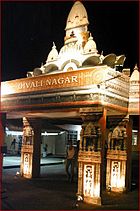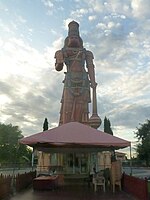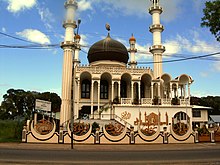
This article is about the demography of the population of Trinidad and Tobago including population density, ethnicity, education level, health of the populace, economic status, religious affiliations and other aspects of the population.

Indentured servitude is a form of labor in which a person is contracted to work without salary for a specific number of years. The contract, called an "indenture", may be entered voluntarily for purported eventual compensation or debt repayment, or imposed involuntarily as a judicial punishment.

Coolie is a pejorative term used for low-wage labourers, typically those of Indian or Chinese descent.

Indian Arrival Day is a holiday celebrated on various days in the nations of the Caribbean, Fiji, South Africa and Mauritius, commemorating the arrival of people from the Indian subcontinent to their respective nations as indentured labours brought by European colonial authorities and their agents. In Guyana, Mauritius, Fiji and Trinidad and Tobago, where it started, it is an official public holiday.

Hinduism is a minority religion in South America, which is followed by even less than 1% of the total continent's population. Hinduism is found in several countries, but is strongest in the Indo-Caribbean populations of Guyana and Suriname. There are about 320,000 Hindus in South America, chiefly the descendants of Indian indentured laborers in the Guianas. There are about 185,000 Hindus in Guyana, 120,000 in Suriname, and some others in French Guiana. In Guyana and Suriname, Hindus form the second largest religion and in some regions and districts, Hindus form the majority. Though in recent times, due to influence of Hindu culture the number of Hindus converts have increased in other countries in South America, including Brazil, Argentina, Venezuela and others.
Indo-Guyanese or Indian-Guyanese, are Guyanese nationals of Indian origin who trace their ancestry to India and the wider subcontinent. They are the descendants of indentured servants and settlers who migrated from India beginning in 1838, and continuing during the British Raj.

Hosay is a Muslim Indo-Caribbean commemoration that is popularly observed in Trinidad and Tobago and Jamaica. In Trinidad and Tobago, multi-coloured model mausoleums or mosque-shaped model tombs known as tadjah are used to display the symbolic part of this commemoration. They are built and paraded, then ritually taken to the sea on last day of observance, and finally discarded into the water. The word tadjah derived from the Arabic word ta'zieh and signifies different cultural meanings depending on the region, time period, occasion, and religion. In Guyana, and Suriname, the festival is called Taziya or in Caribbean Hindustani tadjah in reference to these floats, arguably the most visible and decorative element of this festival.

Caribbean Hindustani is an Indo-Aryan language spoken by Indo-Caribbeans and the Indo-Caribbean diaspora. It is a koiné language mainly based on the Bhojpuri and Awadhi dialects. These Hindustani dialects were the most spoken dialects by the Indians who came as immigrants to the Caribbean from Colonial India as indentured laborers. It is closely related to Fiji Hindi and the Bhojpuri-Hindustani spoken in Mauritius and South Africa.
The Indian indenture system was a system of indentured servitude, by which more than 1.6 million workers from British India were transported to labour in European colonies, as a substitute for slave labor, following the abolition of the trade in the early 19th century. The system expanded after the abolition of slavery in the British Empire in 1833, in the French colonies in 1848, and in the Dutch Empire in 1863. British Indian indentureship lasted till the 1920s. This resulted in the development of a large South Asian diaspora in the Caribbean, Natal, East Africa, Réunion, Mauritius, Sri Lanka, Malaysia, Myanmar, and Fiji, as well as the growth of Indo-Caribbean, Indo-African, Indo-Mauritian, Indo-Fijian, Indo-Malaysian, and Indo-Singaporean populations.
Girmitiyas, also known as Jahajis, were indentured labourers from British India transported to work on plantations in Fiji, South Africa, Eastern Africa, Malaysia, Singapore, and the Caribbean as part of the Indian indenture system.
Indo-Jamaicans are the descendants of people who came from the Indian subcontinent to Jamaica. Indians form the third largest ethnic group in Jamaica after Africans and Multiracials.
Chinese Caribbeans are people who are predominantly of Han Chinese ethnic origin living in the Caribbean. There are small but significant populations of Chinese and their descendants in all countries of the Greater Antilles. They are all part of the large Chinese diaspora known as Overseas Chinese.
Indo-Grenadians or Grenadians, who trace their roots to India, form the largest minority group in Grenada. This term is not generally recognized by Grenadians or indeed Caribbeans. They usually refer to themselves simply as Grenadian or possibly Caribbean. This group was first introduced during the second half of the 19th century when Grenada experimented with indentured labour. By the second half of the 20th century Indians were so integrated into Grenada’s society that a distinct Indian cultural identity was generally invisible. In addition, Indians were involved in every aspect of Grenadian life. Currently there are over 12,000 Grenadians of Indian and mixed-Indian descent.

The languages of the Caribbean reflect the region's diverse history and culture. There are six official languages spoken in the Caribbean:
Indo-Martiniquais are an ethnic group of Martinique, compromising approximately 10% of the population of the island. The Indo-Martiniquais are descendants of indentured labourers of the nineteenth century from India of primarily Tamil and Telugu descent as well as other Indian peoples. They are primarily most concentrated in the northern communes of Martinique, where the main plantations are located. The Indo-Martiniquais speak Antillean a French-based creole.
Indo-Vincentians are an ethnic group in Saint Vincent and the Grenadines who are mainly descendants of indentured laborers who came in the late 19th century to the early 20th century and entrepreneurs who began immigrating in the mid-20th century from the Indian subcontinent. There are about 5,900 people of Indian origin living in the country.
Indo–Saint Lucians or Indian–Saint Lucians, are Saint Lucians whose ancestry lies within the country of India, primarily from Bhojpur and Awadh regions that are in the modern-day Indian states of Bihar, Jharkhand and Uttar Pradesh in Northern India. In 1859, the British began transporting indentured workers from British India to work on plantation estates in Saint Lucia, which had become a British colony in 1814. The first ship carrying 318 indentured workers from India, the Palmyra, arrived in Saint Lucia on 6 May 1859, and the last ship carrying Indian indentured workers, the Volga, arrived on 10 December 1893.
The Indian community in Saint Kitts and Nevis is made up of Indo-Kittitians, Indo-Nevisians, non-resident Indians and persons of Indian origin. Indo-Kittitians and Indo-Nevisians are nationals of Saint Kitts and Nevis whose ancestry lies within the country of India. The community originated from the Indian indentured workers brought to Saint Kitts and Nevis by the British in 1861 and 1874 respectively. By 1884, most of the community had emigrated to Caribbean nations with larger Indian populations such as Trinidad and Tobago, Guyana and Suriname.
The Indian community in the United States Virgin Islands is made up of Indo-Caribbeans, Indian Americans and other persons of Indian origin. The first Indians in the United States Virgin Islands (USVI) arrived in the Danish colony of Saint Croix in June 1863 as indentured workers. However, the nearly all 325 Indians who came to Saint Croix left the island by the 1870s. Nearly two-thirds returned to India, while the others emigrated to Trinidad and Tobago. Some settled in that country, while others returned to India from Trinidad.
Caribbean Shaktism, also known as Kalimai Dharma or Madras Religion in Guyana, refers to the syncretic Shakti Kali/Mariamman worship that has evolved within the Indo-Caribbean Tamil community in countries such as Guyana, Trinidad and Tobago, Guadeloupe, Martinique, Jamaica and Suriname. It can be found across the Caribbean and any South American country with an Indo-Caribbean community. It is a syncretic blend of Dravidian folk religion and Hinduism and has also been influenced by other cultural and religious traditions found in the Caribbean such as Catholicism, Trinidad Orisha, Comfa and Obeah. It is considered to be a form of Folk Tamil Hinduism and many attend services of Vedic Origin, more Orthodox Tamil Origin, and Madrasi origin.















